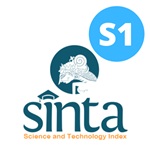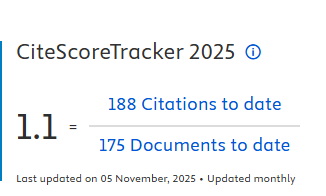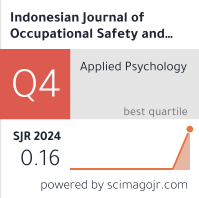HUBUNGAN PREDISPOSING FACTOR DENGAN PERILAKU PENGGUNAAN APD
Downloads
The use of Personal Protective Equipment (PPE) is one of the risk control measures that aim to protect workers from safety and health hazards. The purpose of this study was to analyze factors related to the behavior of the use of PPE in Production Unit I PT Petrokimia Gresik. This research was an analytic-observational research with cross sectional design. Sample in this research were 100 workers. The result was presented in the form of frequency distributions and cross-tabulations then analyzed by chi-square statistic. The results showed that the majority of the workers were well behaved in the use of PPE in the workplace. Statistical analysis showed that the knowledge (p = 0.019; r = 0.346) was the significant factors related to the behavior of the use of PPE and have lower relationships. The conclusion was that the higher the level of knowledge, the better behavior in the use of PPE, while suggestions for the company is the need to increase the amount of training related to K3 especially regarding PPE informally, supervisors to be more assertive to punish or sanction against employees who violate the rules, no matter the level of education, age, and length of service, and the need to increase K3-related surveillance and establish good communication with workers.
Keywords: behavior, personal protective equipment, policies, Gresik, fertilizers and chemicals
Atmodiwirio, Soebagio., 2002. Manajemen Pelatihan. Jakarta: PT Ardadizya
Jaya.
Bisen, Vikram dan Priya. 2010. Industrial Psychology. New Delhi : New Age
International Publishers.
Dyah, Kartika. (2014). Analisis Faktor Yang Berhubungan Dengan Kepatuhan Menggunakan Alat Pelindung Diri (Studi pada Unit Produksi Alumunium Sulfat PT. Liku Telaga Gresik). Gresik
Fitriani, Dian. (2014). Faktor Yang Berhubungan Dengan Penggunaan Alat Pelindung Diri (Apd) Di Unit Produksi III PT. Petrokimia Gresik. Gresik
Halimah, S. (2010). Faktor-Faktor Yang Mempengaruhi Perilaku Aman Karyawan Di Pt. Sim Plant Tambun Ii Tahun 2010. Skripsi. Fakultas Kedokteran Dan Ilmu Kesehatan Universitas Islam Negeri Syarif Hidayatullah. Jakarta.
Ilfani, G. (2013). Analisis Pengaruh Keselamatan Dan Kesehatan Kerja Terhadap Kinerja Karyawan (Studi Pada Pt. Apac Inti Corpora Bawen Jawa Tengah Unit Spinning 2). Skripsi. Fakultas Ekonomika Dan Bisnis Universitas Diponegoro. Semarang.
Jannah, Noer. 2009. Beberapa Faktor yang Berhubungan dengan Pemakaian APD Pada Pekerja Laboratorium Patologi Klinik RSUD Sidoarjo. Skripsi; Surabaya: FKM Universitas Airlangga.
Kurniawan. Dedi. 2009. Hubungan Rambu-Rambu K3 dengan Kepatuhan Pemakaian APD (Studi di bagian Asam Sulfat Pabrik III PT. Petrokimia Gresik). Skripsi; Surabaya: FKM Universitas Airlangga.
Notoatmodjo, S. 2012. Pendidikan dan Perilaku Kesehatan. Jakarta: Rineka Cipta.
Notoatmodjo, S. 2007. Promosi Kesehatan dan Ilmu Perilaku. Jakarta: Rineka Cipta.
Notoatmodjo, S. 2005. Promosi Kesehatan: Teori dan Aplikasi. Jakarta: Rineka Cipta.
Notoatmodjo, S. 2003. Pendidikan dan Perilaku Kesehatan. Jakarta.: Rineka Cipta.
Notoatmodjo, S. 2002. Metode Penelitian Kesehatan. Jakarta: Rineka Cipta
OSHAcademy. 2013. Personal Protective Equipment. Beaverton: OSHAcademy.
Paramita., C.C.P. (2012). Pengaruh Keselamatan Dan Kesehatan Kerja Terhadap Prestasi Kerja Karyawan Pada PT. PLN (Persero) Semarang. Jurnal Administrasi Bisnis. Volume I Nomor 1. Semarang.
Pratama, E.W. (2015). Hubungan Antara Perilaku Pekerja Dengan Kejadian Kecelakaan Kerja Bagian Produksi PT. Linggarjati Mahardika Mulia Di Pacitan. Skripsi. Universitas Negri Semarang.
Peraturan Mentri Tenaga Kerja Dan Transmigrasi RI Nomor 08 Tahun 2010 tentang Alat Pelindung Diri. Jakarta: Sekretariat Negara.
Ramli, Soehatman. 2009. Sistem Manajemen Keselamatan dan Kesehatan Kerja OHSAS 18001. Dian Rakyat : Jakarta.
Reason. 2007. Managing The Risk of Organizational Accidents. Ashgade: Publishing Ltd. Aldershot Hants.
Setiawan., I.V. (2013). Pengaruh Keselamatan dan Kesehatan Kerja Terhadap Produktivitas Karyawan Pada Departemen Jaringan PT PLN (Persero) Area Surabaya Utara. Jurnal Ilmu Manajemen. Volume 1 Nomor 2. Surabaya.
Tarwaka. 2008. Keselamatan dan Kesehatan Kerja: Manajemen dan Implementasi K3 di Tempat Kerja. Surakarta : Harapan Press.
Prasetyo, E. 2015. Pengaruh Pengetahuan, Sikap, Dan Keersediaan Alat Pelindung Diri (APD) Terhadap Kepatuhan Dalam Menggunakan APD Di Unit Coating PT. Pura Barutama Kudus. The 2nd University Research Coloquium 2015.
Sudarmo, Helmi, Z. N, & Marlinae, L. 2016. Perilaku Terhadap Kepatuhan Penggunaan Alat Pelindung Diri (APD) Untuk Pencegahan Penyakit Akibat Kerja. Jurnal Berkala Kesehatan. Vol. 2, Mei 2016:27-44.

In order to be accepted and published by The Indonesian Journal of Occupational Safety and Health, Author(s) who submit an article should complete all the review process. The copyright of received articles assigned to the The Indonesian Journal of Occupational Safety and Health and Department of Safety and Health, Universitas Airlangga as publishers of the journal. The intended copyright includes the rights to publish articles in various forms (including reprints).
The Editorial Team of The Indonesian Journal Of Occupational Safety and Health and Department of Safety and Health strive to ensure that no errors occur in the articles that have been published, both data errors and statements in the article.
Users of this website will be licensed to use materials from this website following the Creative Commons Attribution-NonCommercial-ShareAlike 4.0 International License. No fees charged. Please use the materials accordingly.
------------------------------------------------------------------------------------------------------------------------------------------------------------------------------------------
Attribution ” You must give appropriate credit, provide a link to the license, and indicate if changes were made. You may do so in any reasonable manner, but not in any way that suggests the licensor endorses you or your use.
NonCommercial ” You may not use the material for commercial purposes.
ShareAlike ” If you remix, transform, or build upon the material, you must distribute your contributions under the same license as the original.







 How to Submit Articles in OJS
How to Submit Articles in OJS

























